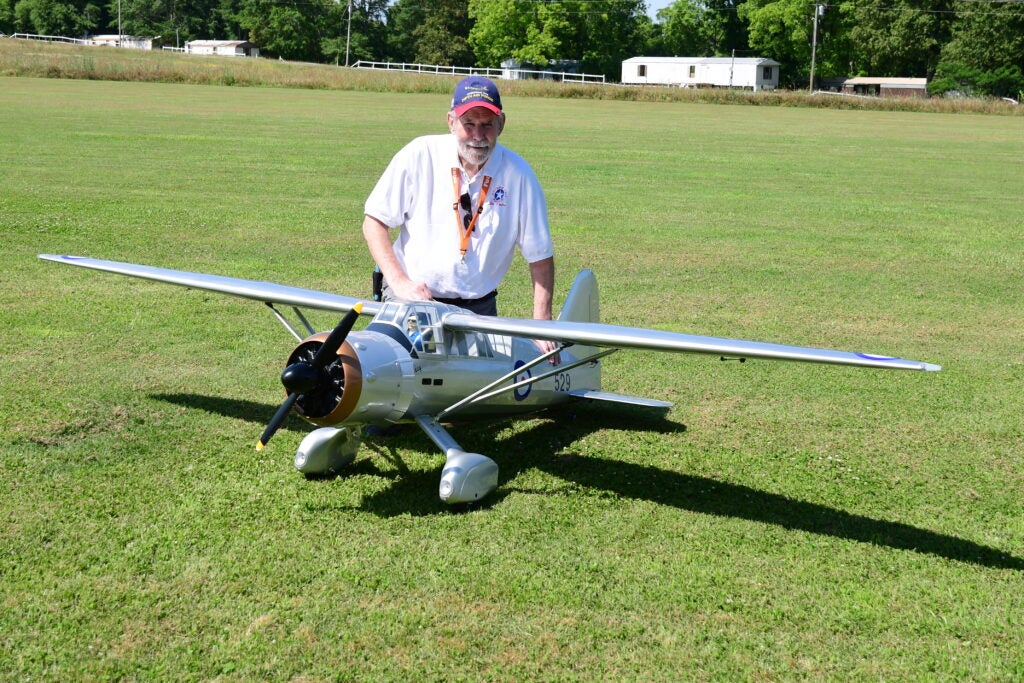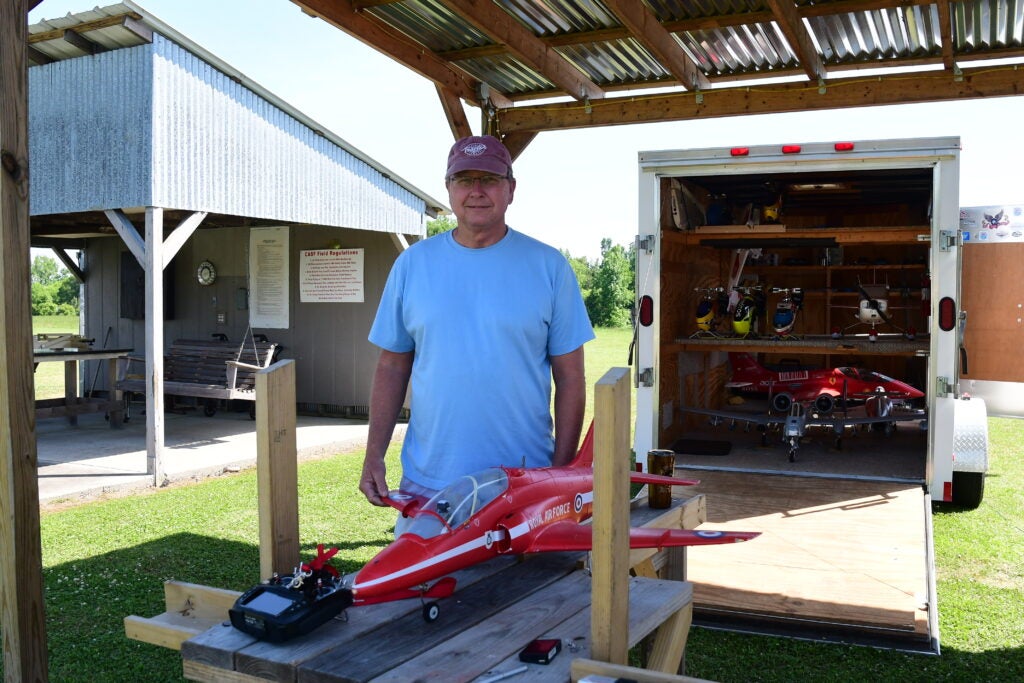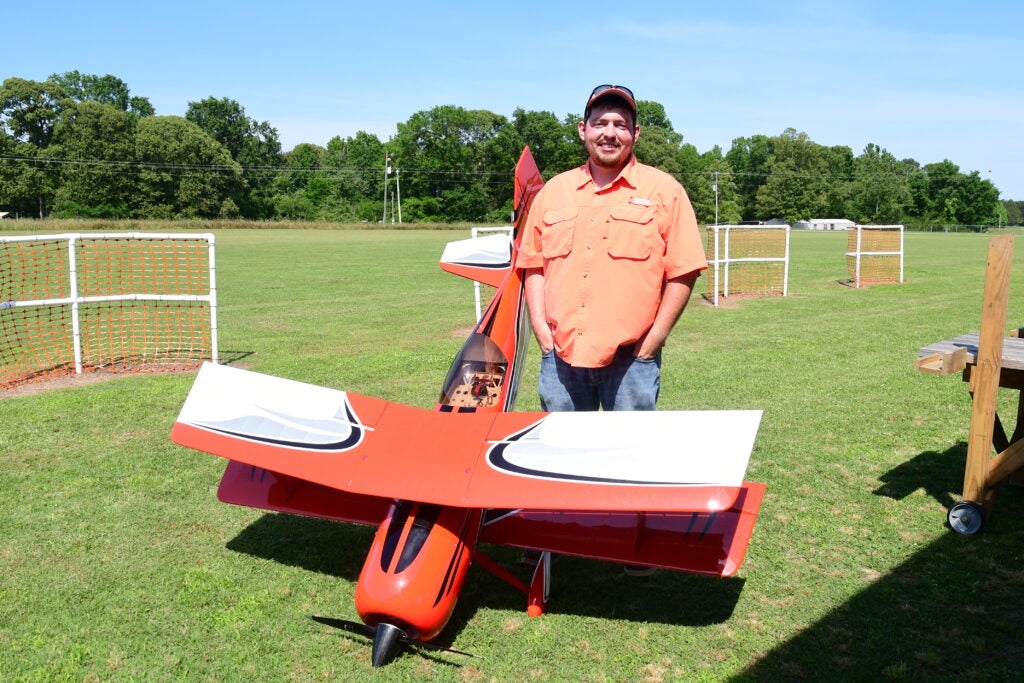
For eons man has desired to take flight. But for many, there are obstacles to this dream — sometimes it is the lack of nerve to fly a plane; sometimes it comes down to the lack of funding.
Yet, for those beguiled by the wild blue yonder, there is another path upward. Many have found it through the hobby of remote control aircraft flying, which is where the Central Alabama Sport Flyers come in.
Imagine, one can fly as free as a bird and yet remain on solid ground. It’s what CASF president Darrell Mims has been doing since he graduated from Thorsby High School in 1970. That’s about when the club started, but back then people flew the model planes on two lines — it was called line control, or U control.
“Mostly you stood out in a circle in the middle of a field with a handle and a pair of lines, and guided your plane around the circle. Of course you could go up and down, inverted and do all kinds of stuff,” Mims said. “That’s the way it all started, but then about 1969-70, radio got more sophisticated, and everybody was going to this type radio. Everything now is computerized, of course.”
Mims might have been the first person in Chilton County to own an RC plane. Around 1970, he bought a radio model with proportional controls, and before that he had put together wooden planes in some form since age 13.
“The way I got started was, I tried to fly this thing off the ground, and it never would get off the ground,” he recalled. “I told my brother, ‘Pick that thing up and throw it.’ He picked the plane up, ran, threw it, and I’ve been flying ever since.”
Mims remembers purchasing RC kits and fuel from Jeff Miller at the Five and Dime. There, he could find whatever he needed for the hobby. Today, Mims has 10 or more RC planes to keep up.
He traces his love for aviation back to spending time with his father, who owned a life-size plane back in the mid-’60s.
“We used to go out to the airport with him. Charlie Wade was there. We just had a good time on Sunday afternoons just hanging around the airport,” Mims said.
Mims was an aircraft mechanic for 45 years. He earned his aircraft mechanic’s license at Ozark in 1976, but he sticks mostly
to the RC world nowadays.
“I have flown, but I guess I’ve just got my feet on the ground now,” he said.

About the CASF
The Central Alabama Sport Flyers own a strip of land located at 3704 County Road 47 outside Clanton. It comprises a 975-foot grass runway, clubhouse, restrooms and covered stations alongside the runway for flight preparation and observation.
There are currently about 35 members of the club, and their skill levels range from beginner to expert. They meet most Sundays
about 1 p.m. to fly, sometimes staying out until dark. They also have cookouts and even night flights, which obviously requires more skill.
Annual dues paid by club members help fund regular upkeep of the grounds, utility bills and maintenance on club facilities.
“We’ve flown out of pastures, stadiums and all different places, but this is our property here, and we’ve paid it off and it’s ours as long as we want it,” Mims said.
There are different styles of RC planes.
Some have a body made from a foam material; others consist of balsa wood and plastic. Mims prefers the latter because it’s what he grew up using. They primarily arrive pre-manufactured, but some assembly is required due to the fragility of moving parts.
Jim Williams of Indian Springs with his “Lizzie” Lysander model.
The moving parts that control the direction of the craft are operated by servo motors, which are self-contained electrical devices that rotate to the desired angle.
When it comes to propulsion, some planes are powered by a fan that creates a rush of air like a jet. Others have actual propellers that do the job. Many are batterypowered while others run on nitro fuel, known as “glow fuel.”
“Basically, it’s just like you’re sitting in the airplane, and you’ve got left, right, like that, see how it moves?” Mims said while demonstrating the servos on one of his models.
“It can move a little bit, it can move a lot. It’s just like a real airplane.”
With plenty of practice, one can get really good at flying RC planes — good enough to do a few tricks.
“You can stall one, you can flip one, you can spin, roll, whatever,” Mims said, adding a warning to potential new recruits — Don’t get too attached to your plane, because it will eventually crash.
“Sometimes you can repair them,” he said. “It’s not really bad a lot of times. It just takes a lot of patience to put the pieces back together.”

Father-son flights
Wade Johnson has flown RC planes off and on for about 35 years, and has done so with his oldest son, Josh, for eight years. Johnson took flying lessons as a teenager but did not get his certification.
“I’ve always been interested in avionics; I’ve always been interested in planes,” Johnson recalled. “As a kid, I’d be at the house, and I’d hear one, I’d have to look up and see it. I just thought it would be neat to be able to have a scaleddown version, something that I could fly myself because I couldn’t really afford a real plane.”
Johnson admitted that for several years he got out of the hobby in order to spend more time with his family, but that soon took care of itself.
“When my oldest son sparked an interest in it, it gave (us) some father and son time teaching him how to fly and letting him enjoy the hobby that I’ve always enjoyed,” he explained.
Johnson has worked for the Clanton Police Department for more than 30 years, and his experience with the
Flyers led to the department acquiring a drone. He said the biggest difference is that most drones have a camera attached. When operating the police drone, Johnson wears goggles that enable him to see what the drone “sees” in mid-flight.
With RC planes, however, the operator is usually limited to the naked eye. In fact, it is against FAA regulations to fly them farther than the eye can see.
“With these planes, you can’t fly them out of sight because you’ve got to be able to see it and see what orientation it’s in in order to control it,” Johnson said.
With advances in technology, however, the planes have gotten lighter, stronger, more affordable and more efficient.
One can purchase an RC plane starter kit for $200 or less, depending on the type of materials used and the size model.
“Pretty much everything’s gone electric now because it’s cleaner, it’s more efficient. Battery technology’s gotten better. Fly times are longer,” Johnson said.
For more information about CASF, call 205-755-6257, email jdmims52@gmail.com or visit the club’s page on Facebook.
